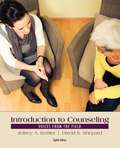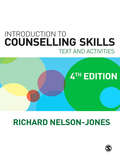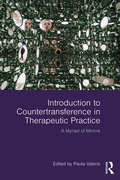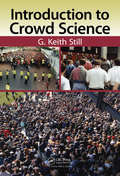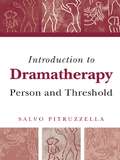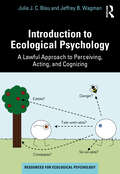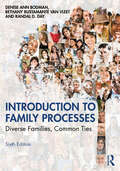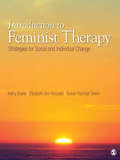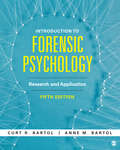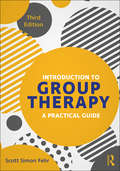- Table View
- List View
Introduction to Counseling: A Condensed Text
by Jennifer Marshall Trey Fitch Miles Matise Gulnara McCulloughThis CACREP aligned text outlines core concepts of the counseling profession alongside hundreds of practical study questions and case studies for students and professors. Designed for use not just in class but also as a guide for students studying for national licensing exams and the CPCE, chapters cover areas including ethical and legal issues, theories of counseling, career development, multicultural and group counseling, special topics, and more. Hundreds of PowerPoint slides are included to assist professors with class preparation, and professors will also find study questions for each chapter and a sample final exam that easily be applied in online learning platforms. Written in a readable, concise format designed for adult learners, Introduction to Counseling is an essential resource that counseling students will want to keep long after graduation.
Introduction to Counseling: Voices from the Field
by Jeffrey A. Kottler David S. ShepardINTRODUCTION TO COUNSELING, Eighth Edition provides a comprehensive overview of the counseling profession while encouraging readers to examine the day-to-day realities of being a counselor as well as their motivation for choosing the profession. Coverage includes information on what counseling is as well as its history, theoretical orientations, applications, and professional issues. As readers become engaged in the process of learning and applying counseling concepts, they get an unparalleled look at what their professional futures may hold.
Introduction to Counselling Skills: Text and Activities
by Richard Nelson-Jones`As a course book or an aide to individual learning this book contains a wealth of information and guidance based on years of study and practice. It is easy to use because it is clearly signposted. I particularly like the way the author addresses the range of issues a student needs to consider before embarking on a counselling course. The structure of building block by block, skill by skill simplifies assessment' - Counselling and Psychotherapy Journal Good counselling skills are the key to effective helping relationships. Introduction to Counselling Skills, Second Edition is designed to help readers' acquire and develop these skills, using an easy-to-follow, three-stage model. Drawing on many years experience as a counsellor, trainer and writer, Richard Nelson-Jones describes in detail each stage in the helping process and gives examples to show how the skills work in practice. The examples also demonstrate the variety of contexts in which counselling skills are commonly used, as well as the diversity of issues and problems they can help to address. The book covers: }} what counselling skills are }} how to conduct sessions }} ways to clarify and expand your understanding }} how to improve your listening skills }} ethical skills. Introduction to Counselling Skills, Second Edition is full of practical features designed to aid learning, including activities related to the particular skill being described, learning outcomes, examples, summaries and a glossary of key terms. For this, the Second Edition, the book has been fully up-dated and new material has been added on the diversity of helpers and clients, the use of training groups and supervision. Combining a clear explanation of skills, with a host of practical activities, Introduction to Counselling Skills, Second Edition is the ideal text for introductory courses in counselling skills, counselling and many other professional areas including health care, management, education and social work.
Introduction to Counselling Survivors of Interpersonal Trauma
by Christiane SandersonVictims of sexual and physical trauma can feel lost and disconnected from themselves and others. Christiane Sanderson's new book explains how counsellors can restore connection to self and others, and facilitate recovery within a safe and supportive therapeutic relationship. To understand fully the harm caused by interpersonal trauma, professionals must first recognize its complex nature, and the psychological and emotional impact of exposure to control and terror. This book examines the therapeutic techniques and specific challenges faced by professionals when working with survivors of interpersonal trauma. The author explores issues such as safety and protection, the long-term effects of trauma and the importance of visiting past experiences and assessing their impact on the present. This book is essential reading for counsellors, therapists, social workers, mental health professionals, health care professionals including GPs and midwives, legal professionals and all those working with survivors of interpersonal trauma such as sexual violence, child abuse, domestic abuse, elder abuse, institutional abuse and abuse by professionals
Introduction to Countertransference in Therapeutic Practice: A Myriad of Mirrors
by Paola ValerioWhile transference has been fully described in the literature, countertransference has been viewed as its ugly sibling, and hence there are still not as many reflective accounts or guidance for trainees about how to handle difficult emotions, such as shame and envy and conflict in the consulting room. As a counterpoint, this book provides an integrative guide for therapists on the concept of countertransference, and takes a critical stance on the phenomenon, and theorising, about the "so-called" countertransference, viewing it as a framework to explore the transformative potential in managing strong emotions and difficult transactions. With an explicit focus on teaching, this book informs therapeutic practice by mixing theories and case studies from the authors' own clinical and teaching experiences, which involves the reader in case studies, reflection and action points. Countertransference is explored in a wide range of clinical settings, including in reflective practice and in research in the field of therapy, as well as in art therapy and in the school setting. It also considers countertransference in dream interpretation, in the supervision and teaching environment and in work with groups and organisations. Introduction to Countertransference in Therapeutic Practice offers psychotherapists and counsellors, both practicing and in training, a comprehensive overview of this important concept, from its roots in Freud’s work to its place today in a global, transcultural society.
Introduction to Crowd Science
by G Keith StillThis well-grounded and practical guide highlights the underlying causes of crowd disasters and mass fatalities-giving readers insight into the root causes of crowd-related accidents. It presents a clearer understanding of crowd dynamics and provides the reader with fundamental modeling techniques to plan and manage and improve crowd safety in places of public assembly. The book is written for students and professionals in a number of areas such as event planning, licensing/approval, and event operation, including emergency services.
Introduction to Dramatherapy: Person and Threshold
by Salvo PitruzzellaIntroduction to Dramatherapy provides a theoretical framework for the practice of dramatherapy, and examines the relationship between the 'self' and the 'other'; the understanding of which, the author argues, is key to harnessing the full potential of dramatherapy as a healing medium. In Part 1, the individual is introduced in terms of the dramatic metaphor, concentrating on the central issue of identity and the mediation between the internal and external worlds. In Part 2 the elements that make up dramatic reality, specifically play, narrative and role, are examined, and in the final part we witness the value of dramatherapy in practice in practice in a range of clinical settings. This is not simply a 'how to do dramatherapy' book - it provides an essential foundation in the theory of the subject that will be of great interest to those studying or practicing dramatherapy.
Introduction to Ecological Psychology: A Lawful Approach to Perceiving, Acting, and Cognizing (Resources for Ecological Psychology Series)
by Jeffrey B. Wagman Julia J. BlauIntroduction to Ecological Psychology is a highly accessible book that offers an overview of the fundamental theoretical foundations of Ecological Psychology. The authors, Julia J.C. Blau and Jeffrey B. Wagman, provide a broad coverage of the topic, including discussion of perception-action as well as development, cognition, social interaction, and application to real world problems. Concepts are presented in the book using a conversational writing style and everyday examples that introduce novice readers to the problems of perception and action and demonstrate the application of the ecological approach theories to broader philosophical questions. Blau and Wagman explain how ecological psychology might be pertinent to both classic and newer issues in psychology. The authors move beyond the traditional scope of the discipline to effectively illustrate concepts of dynamics, evolution, self-organization, and physical intelligence in ecological psychology. This book is an essential guide to the basics for students and professionals in ecological psychology, sensation and perception, cognition, and development. It is also indispensable reading for anyone interested in ecological and developmental studies.
Introduction to Educational Gerontology (Series in Death, Dying, and Bereavement)
by Ronald H. Sherron D. Barry LumsdenEducational gerontology is the study of the changes in the learning process caused by old age. This new edition provides an update of developments in this field of research. The volume probes topics such as implications for education for the aging, reminiscence, methods of teaching, social exchange and equal opportunity.
Introduction to Educational Psychology (Routledge Revivals)
by William Clark TrowFirst published in 1937, Introduction to Educational Psychology provides a comprehensive overview of the science of psychology and its applications in the field of education. It deals with important themes like individual needs; emotion and personality adjustments; intelligence and measurement; perception and meaning; the acquisition of knowledge; insight and thinking; mental efficiency; and childhood and youth. This is an important historical reference work for students of psychology and educational psychology.
Introduction to Family Processes: Diverse Families, Common Ties
by Randal D. Day Denise Ann Bodman Bethany Bustamante Van VleetIntroduction to Family Processes: Diverse Families, Common Ties serves to provide an explanation of the complex workings of inner family life. The text primarily focuses on family processes and dynamics (the "inside" of families) as opposed to sociological trends, political topics, or the individual psychological approach. The text further presents the research underlying these processes and effectively presents ways to increase the positive aspects of family life. This edition has been updated to include current research and contemporary topics. The text has been divided into four parts: Foundations, Building and Establishing Families, Maintaining Families, and Change/Turbulence/Gains/Losses. While the research methods chapter still provides an introductory examination of family science research, it now includes an expanded discussion on research design, methods, and advances in the area. A new chapter, titled "Forgiveness, Kindness, Hope, and Gratitude" has been incorporated to amplify positive family processes and highlight emerging research. This edition provides added emphasis on diverse families (e.g., race/ethnicity, family structure, LGBTQIA, ability, culture, and family formation), and each chapter includes a new "Discussions in Diversity" section related to that chapter. The authors have consciously included an epilogue as a way of reflecting on what they have learned, along with what they hope to learn in the future. Aimed at courses related to family studies and family dynamics, this text provides a comprehensive review of family processes. Whether it is used for undergraduate or graduate classes, professional growth, or personal enrichment, the text assists readers in enhancing the positive aspects of family life, avoiding undesirable aspects, and more effectively managing the challenges and obstacles families face that cannot be avoided. Thus, the text holds an appeal for people who live (or will live) in families, as well as those who want to work with families.
Introduction to Family Processes: Fifth Edition
by Randal D. DayWhat goes on "behind closed doors" in families is examined in this text. Through his storytelling style, Randy Day introduces readers to the family processes approach – the strategies and behaviors families use to achieve goals. The emphasis is on how families work and interact rather than on the psychological, sociological, or economic processes. It examines emotions in families, communication, relationship formation/dissolution, family rituals, and power and conflict. Chapters open with a Preview and conclude with a Summary, Study Questions, Key Terms, and Suggested Readings. Principle Boxes highlight key concepts and a Glossary defines the key terms listed at the ends of the chapters. Significantly updated with 50% new material including many new references and examples, the new edition features: A new chapter that introduces the discipline’s methodology A new chapter on relationship formation including partner selection, falling in love, commitment, sexuality, passion, and intimacy A new design reformatted to tie in with the book’s website at http://www.psypress.com/family-processes which now contains the Chapter Activity Questions that reinforce critical thinking skills, the Journal Activities that strengthen students' personal connection to the material, and the chapter Previews and Key Terms for review purposes An Instructor’s Web Resource at http://www.psypress.com/family-processes with small group and in-class exercises, lecture outlines in PowerPoint, topics for debate, suggested films, and multiple-choice, true/false, matching, and essay questions More material on the role of gender, power, genetics, and personality in relationships; families from diverse cultural and ethnic backgrounds and the impact of work and technology on the family; the changing nature of family structures including single parenting and gay unions; and stresses in family life. Written for undergraduate courses on family processes, family dynamics, family life, the family, and/or marriage & family interaction taught in family studies, human development, psychology, sociology, social work, education, consumer sciences, home economics, health, and nursing departments, this book also appeals to those who want to maximize the positive parts of family life and manage the inevitable challenges.
Introduction to Feminist Therapy: Strategies for Social and Individual Change
by Dr Kathy M Evans Dr Elizabeth A. Kincade Susan Rachael SeemFocusing on the practical application of feminist theory to clinical experience, Introduction to Feminist Therapy provides guidelines to help therapists master social action and empowerment techniques, feminist diagnostic and assessment strategies, and gender-role and power analyses to foster individual and social change. This guide is ideal for graduate students enrolled in a techniques of counseling course and practitioners who wish to incorporate feminist therapy into their current approach, including how to apply feminist therapy to both women and men and how to deal with the gender issues of both sexes. Client/Therapist dialogues provide readers with examples of how each technique actually works in a therapeutic session. The text also provides case studies, coverage of ethical issues, and feminist assessment guidelines that show readers how to conduct a feminist assessment with and without using the DSM-IV-TR.
Introduction to Forensic Psychology: Clinical and Social Psychological Perspectives
by David Shapiro Lenore E. Walker Stephanie AklThis book provides a broad overview of the history and practice of forensic psychology, illustrating the principles of how psychological knowledge can inform judges and juries in the U.S. legal system with reference to several high publicity cases. The second edition contains new case law and discusses its implications in the major areas of forensics, examining new developments in juvenile justice, malpractice complaints, and reproductive rights, among other topics. The authors address specific aspects of forensic psychology within seven distinct sections:What is Forensic Psychology?Understanding the Criminal MindCan Psychologists Measure Pain and Suffering?Family Law and Fitness to ParentJuvenile JusticeLegal Consultation Based on Social PsychologyPractical Tips for Forensic Psychology Experts An essential resource for current and aspiring forensic psychologists, the second edition of Introduction to Forensic Psychology serves as a thorough introduction to a complex field, featuring updated cases and related legal developments.
Introduction to Forensic Psychology: Essentials for Law Enforcement
by Stephanie Scott-SnyderResearch indicates that there are psychological principles at play in the situations encountered by law enforcement personnel. The book fulfills an important need in the ever-evolving field of criminal justice, providing a working knowledge of forensic psychology and its application to interview strategies, homicide, emotional disturbance, sexual and domestic violence, hostage negotiations, and other situations. It will help law enforcement to understand, interpret, and anticipate behavior, while responding safely and effectively.
Introduction to Forensic Psychology: Research and Application
by Anne M. Bartol Curtis R. BartolFilled with real–life examples, practical applications, and case law discussions, Forensic Psychology: Research and Application, Fourth Edition covers new and emerging fields of study, the many areas where psychology plays a significant role in the civil and criminal justice systems, and the wide range of issues that are an integral part of the forensic psychologist’s day-to-day work. This unique, career-oriented textbook emphasizes a multicultural perspective that focuses on the application of psychological knowledge and research. Authors Curt and Anne Bartol expose readers to emerging specializations within forensic psychology, including investigative psychology, family forensic psychology, and police and public safety psychology. The authors also provide extensive, up-to-date references for students to find more material on the subject areas covered.
Introduction to Forensic Psychology: Research and Application
by Anne M. Bartol Curtis R. BartolFilled with real–life examples, practical applications, and case law discussions, Forensic Psychology: Research and Application, Fourth Edition covers new and emerging fields of study, the many areas where psychology plays a significant role in the civil and criminal justice systems, and the wide range of issues that are an integral part of the forensic psychologist’s day-to-day work. This unique, career-oriented textbook emphasizes a multicultural perspective that focuses on the application of psychological knowledge and research. Authors Curt and Anne Bartol expose readers to emerging specializations within forensic psychology, including investigative psychology, family forensic psychology, and police and public safety psychology. The authors also provide extensive, up-to-date references for students to find more material on the subject areas covered.
Introduction to Forensic Psychology: Research and Application
by Curt R. Bartol Anne M. BartolWritten by authors with extensive experience in the field and in the classroom, Introduction to Forensic Psychology: Research and Application, Fifth Edition, by Curt R. Bartol and Anne M. Bartol, demonstrates how to analyze psychological knowledge and research findings and then apply these findings to the civil and criminal justice systems. Focusing on research-based forensic practice and practical application, this text uses real-life examples and case law discussions to define and explore forensic psychology. This text introduces you to emerging specializations within forensic psychology, including investigative psychology, family forensic psychology, and police and public safety psychology. You will develop a multicultural perspective with an ethnic and racial sensitivity, which is critical to the successful practice of forensic psychology. New to the Fifth Edition: Updated statistics, research, and case law, such as recent Aid in Dying legislation, as well as analysis of recent events, help you see the real-world applications to current events. Updated Focus boxes empower you to dig deeper into current issues, such as mental health courts, community-oriented policing, child abduction, hate crimes, the death penalty, and more. All Focus boxes also contain discussion questions for you to debate in a classroom setting. All new From My Perspective boxes provide you with information about career choices as well as helpful advice about pursuing your career goals. Increased attention to immigration-related issues offers you additional insights into immigration proceedings and ways to consult with the courts. Additional coverage of human trafficking and online sexual predators enables you to better understand the psychological effects on victims and the services available to help. Current research on violent video games, cyberbullying, and cyberstalking provides real examples of the effects of violent media. New research on juveniles allows you to see the important contributions of neuropsychologists, particularly in terms of brain development in adolescents and promising community-based treatment approaches for juveniles.
Introduction to Forensic Psychology: Research and Application
by Curt R. Bartol Anne M. BartolWritten by authors with extensive experience in the field and in the classroom, Introduction to Forensic Psychology: Research and Application, Fifth Edition, by Curt R. Bartol and Anne M. Bartol, demonstrates how to analyze psychological knowledge and research findings and then apply these findings to the civil and criminal justice systems. Focusing on research-based forensic practice and practical application, this text uses real-life examples and case law discussions to define and explore forensic psychology. This text introduces you to emerging specializations within forensic psychology, including investigative psychology, family forensic psychology, and police and public safety psychology. You will develop a multicultural perspective with an ethnic and racial sensitivity, which is critical to the successful practice of forensic psychology. New to the Fifth Edition: Updated statistics, research, and case law, such as recent Aid in Dying legislation, as well as analysis of recent events, help you see the real-world applications to current events. Updated Focus boxes empower you to dig deeper into current issues, such as mental health courts, community-oriented policing, child abduction, hate crimes, the death penalty, and more. All Focus boxes also contain discussion questions for you to debate in a classroom setting. All new From My Perspective boxes provide you with information about career choices as well as helpful advice about pursuing your career goals. Increased attention to immigration-related issues offers you additional insights into immigration proceedings and ways to consult with the courts. Additional coverage of human trafficking and online sexual predators enables you to better understand the psychological effects on victims and the services available to help. Current research on violent video games, cyberbullying, and cyberstalking provides real examples of the effects of violent media. New research on juveniles allows you to see the important contributions of neuropsychologists, particularly in terms of brain development in adolescents and promising community-based treatment approaches for juveniles.
Introduction to Forensic Psychology: Research and Application
by Anne M. Bartol Curtis R. BartolWritten by authors with extensive experience in the field and in the classroom, Introduction to Forensic Psychology: Research and Application, Sixth Edition demonstrates how to analyze psychological knowledge and research findings and apply these findings to the civil and criminal justice systems. Focusing on research-based forensic practice and practical application, the authors use real-life examples and case law discussions to define and explore forensic psychology. Students are introduced to emerging specializations within forensic psychology, including investigative psychology, family forensic psychology, and police and public safety psychology. Research related to bias, diversity, and discrimination is included throughout the text to give students a multicultural perspective that is critical to the successful practice of forensic psychology. Included with this title: Instructor Online Resources: Access online resources for this title via the password-protected Instructor Resource Site.
Introduction to Forensic Psychology: Research and Application
by Anne M. Bartol Curtis R. BartolWritten by authors with extensive experience in the field and in the classroom, Introduction to Forensic Psychology: Research and Application, Sixth Edition demonstrates how to analyze psychological knowledge and research findings and apply these findings to the civil and criminal justice systems. Focusing on research-based forensic practice and practical application, the authors use real-life examples and case law discussions to define and explore forensic psychology. Students are introduced to emerging specializations within forensic psychology, including investigative psychology, family forensic psychology, and police and public safety psychology. Research related to bias, diversity, and discrimination is included throughout the text to give students a multicultural perspective that is critical to the successful practice of forensic psychology. Included with this title: Instructor Online Resources: Access online resources for this title via the password-protected Instructor Resource Site.
Introduction to Forensic Psychology: Research and Application
by Curtis R. Bartol Anne M. BartolWritten by authors with extensive experience in both the field and classroom, Introduction to Forensic Psychology: Research and Application, Seventh Edition equips students with the skills to analyze psychological knowledge and research findings, applying them effectively to both civil and criminal justice systems. The text is structured to cover five vital areas: law enforcement and investigative psychology, legal psychology, criminal psychology, victimology and victim services, and correctional psychology, while also addressing emerging technologies such as facial recognition and artificial intelligence. Moreover, it emphasizes an essential multicultural perspective, underscoring the need for sensitivity to ethnic, gender, cultural, and racial dynamics, preparing students to navigate the diverse challenges they will encounter in their professional careers.
Introduction to Forensic Psychology: Research and Application
by Curtis R. Bartol Anne M. BartolWritten by authors with extensive experience in both the field and classroom, Introduction to Forensic Psychology: Research and Application, Seventh Edition equips students with the skills to analyze psychological knowledge and research findings, applying them effectively to both civil and criminal justice systems. The text is structured to cover five vital areas: law enforcement and investigative psychology, legal psychology, criminal psychology, victimology and victim services, and correctional psychology, while also addressing emerging technologies such as facial recognition and artificial intelligence. Moreover, it emphasizes an essential multicultural perspective, underscoring the need for sensitivity to ethnic, gender, cultural, and racial dynamics, preparing students to navigate the diverse challenges they will encounter in their professional careers.
Introduction to Group Therapy: A Practical Guide (Third Edition)
by Scott Simon FehrThe main objective of Introduction to Group Therapy is to give the reader a solid understanding of group therapy while simultaneously creating scholars in the group therapy paradigm. This unique book combines theory and practice in a reader-friendly format, presenting practical suggestions to guide both students and novice group therapists through the nuts and bolts of running a group. This third edition continues the clinically relevant and highly readable work of the previous editions, demonstrating the therapeutic power group therapy has in conflict resolution and personality change. A proven resource for introductory and advanced coursework, the book promotes group therapy at the grassroots level – students – where it has the most opportunity to be put into effect.
Introduction to Group Therapy: A Practical Guide, Second Edition
by Scott Simon FehrProvides a solid foundation for anyone interested in group therapy! Introduction to Group Therapy: A Practical Guide, Second Edition continues the clinically relevant and highly readable work of the original, demonstrating the therapeutic power group therapy has in conflict resolution and personality change. This unique book combines theory and practice in a reader-friendly format, presenting practical suggestions in areas rarely covered in academic settings. A proven resource for introductory and advanced coursework, the book promotes group therapy at the grassroots level-students-where it has the most opportunity to be put into effect. Introduction to Group Therapy: A Practical Guide, Second Edition expands on issues presented in the book's first edition and introduces new information on topics such as the historical beginnings of group therapy, theories, modalities, practical issues of how to set up an office for an effective group environment, surviving your training sites, problem clients, contemporary issues drawn from online discussion, and developing a group practice. The book also includes case studies, review questions, a glossary, appendices of relevant topics, and an extensive bibliography. Changes to Introduction to Group Therapy: A Practical Guide include: the expansion of "A Case Study" into two chapters to include analysis from 17 senior clinicians a new chapter on group therapy as a negative experience a new chapter on group psychotherapy as a specialty new material on self-protection new material on the training site and the problematic client and much more! Thorough, well organized, and based on first-hand accounts, this book is also a great resource for experienced clinicians who need proven and expert advice from colleagues in the field. Introduction to Group Therapy, Second Edition effectively combines theory and practical suggestions to help you offer improved therapy to clients.

